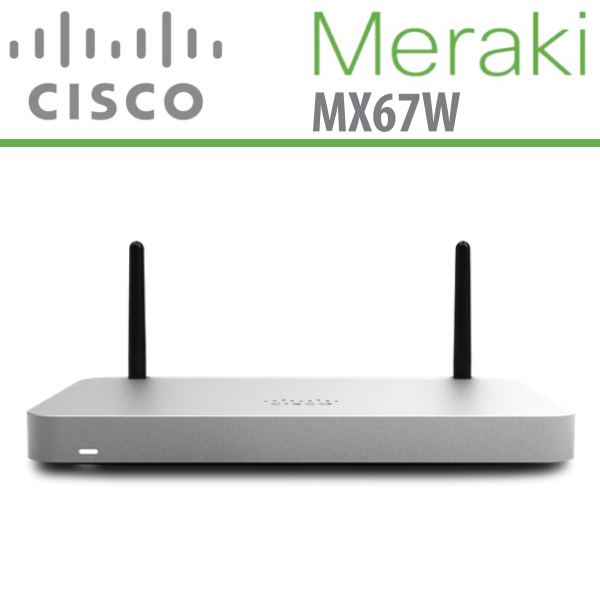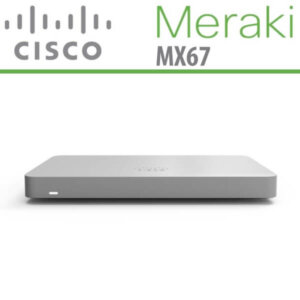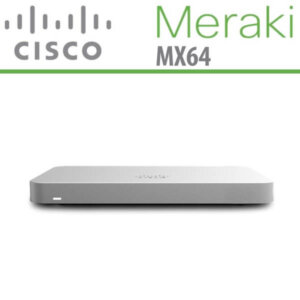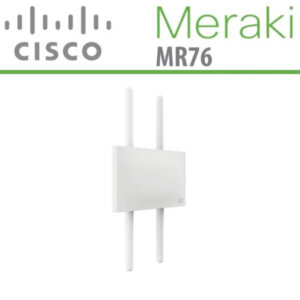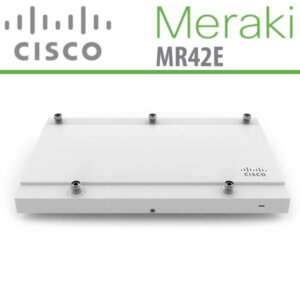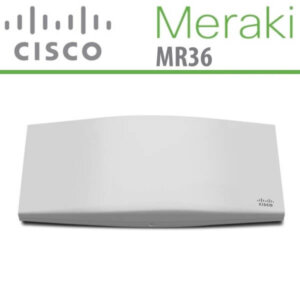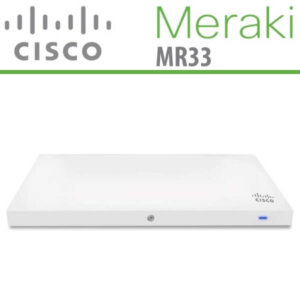Description
Meraki MX67W Security Appliance Nigeria
Meraki MX67W Nigeria Security Appliances are ideal for organizations with large numbers of distributed sites. Since the MX is 100% cloud man – aged, installation and remote management is simple. The Cisco Meraki MX67W Nigeria has a comprehensive suite of network services, eliminating the need for multiple appliances. These services include Layer 7 application firewall, content filtering, web search filtering, SNORT based intrusion prevention, web caching, Intelligent WAN with multiple uplinks and 4G failover.
Features
A Complete Solution for Distributed Networks
The Cisco Meraki MX67W Nigeria provides a complete networking and security solution that typically requires up to four appliances: branch router, next-generation firewall, Layer 7 traffic shaper, and CIPA-compliant content filter. This integrated architecture dramatically reduces up-front costs and ongoing support and maintenance. Moreover, it provides unified, single pane-of-glass management, speeding deployment and eliminating the need for specialized training.
The First Cloud Managed Networking and Security Platform
The Cisco Meraki MX67W Nigeria is a complete networking and security solution, designed to make distributed networks fast, secure, and easy to manage. The MX is managed entirely through Cisco Meraki’s web based dashboard. Designed with intuitive controls for IT generalists, the MX requires no training or specialized staff. The MX will even self-provision, allowing for remote branch deployments without on-site IT.
Powerful Hardware Platform
The Meraki MX67W Nigeria hardware platform is purpose-built for cloud management, with CPU and memory resources designed to provide application and content-aware security at the edge. The MX’s robust platform enables advanced features like layer 7 application traffic shaping, content filtering, antivirus/antiphishing, and site-to-site VPN, while providing the throughput and capacity for modern, high-density networks.
Easy to Manage Without Training or On-Site Networking Expertise
The MX was designed for ease of use, even in branches without on-site IT. An intuitive interface, contextual help, and real-time support from the cloud eliminate specialized training. To deploy the MX in remote locations, simply connect the MX to the Internet, and it will securely self-provision from the cloud. Firmware upgrades, security patches, and signature updates are all delivered seamlessly from the cloud, ensuring that the MX is always up to date. Integrating broad security and networking features into a single intuitive device drastically reduces complexity in the branch.
Secure, Reliable Distributed Networking Without Costly MPLS
The MX eliminates costly MPLS tunnels with secure site-to-site VPN over redundant Internet connections. Using IPsec over the Internet, the MX links your branches to headquarters as well as to one another as if connected with a virtual Ethernet cable. Configuration headaches like NAT traversal are handled automatically from the cloud. The MX70’s dual WAN ports with balancing and failover enable the use of redundant commodity Internet connections, providing more bandwidth and higher reliability than MPLS, at a fraction of the cost.
Connects and Secures Branches from the Cloud
Cisco Meraki’s cloud management platform makes it easy to deploy secure, interconnected, centrally managed multi-site networks. Add new sites in seconds with auto-configuring VPN. Centrally manage user, content and application-aware firewall policies across your entire network.
Control Applications, Users, and Devices
The Meraki MX67W Nigeria provides complete control over users, content, and applications, giving the visibility, security, and control required for mixed-use networks. Layer 7 fingerprinting technology lets administrators block objectionable content and applications and prevent recreational apps like BitTorrent from wasting precious bandwidth. Likewise, the MX can prioritize critical applications like voice and video. User fingerprinting identifies clients by name, operating system, or device (e.g. iPad). Fast search, automatic reports, and device quarantine provide complete visibility and control over the users across the entire network.
Increases WAN Performance and Reduces Bandwidth Costs
Block unwanted bandwidth hogs like BitTorrent, and add capacity with WAN load balancing. Cache, deduplicate, and optimize traffic with WAN optimization to lower bandwidth consumption by up to 99% and improve application performance by up to 209x.
Specifications
General
- Recommended Use Cases : Small branch
- Recommended Clients : 50
- Stateful Firewall Throughput : 450 Mbps
- Advanced Security Throughput : 300 Mbps
- Maximum VPN Throughput : 200 Mbps
- Maximum Concurrent VPN Tunnels : 50
- WAN Interfaces (Dedicated) : 1 x GbE RJ45 1 x USB (cellular failover1 )
- Dual-purpose : 1 x GbE RJ45
- LAN Interfaces : Fixed 4 x GbE RJ45
- Mounting : Desktop or wall mount
- Dimensions (w x d x h) 9.4”x 5.1” x 1.1” (239mm x 130mm x 27mm)
- Weight : 1.74 lb (0.7kg)
- Power Supply : 30W DC
- Operating Temperature : 32°F to 113°F (0°C to 45°C)
- Humidity : 5% to 95%
Management
- Managed via the web using the Cisco Meraki dashboard
- Single-pane-of-glass into managing wired and wireless networks
- Zero-touch remote deployment (no staging needed)
- Automatic firmware upgrades and security patches
- Templates based multi-network management
- Org-level two-factor authentication and single sign-on
- Role-based administration with change logging and alerts
Monitoring and Reporting
- Throughput, connectivity monitoring and email alerts
- Detailed historical per-port and per-client usage statistics
- Application usage statistics
- Org-level change logs for compliance and change management
- VPN tunnel and latency monitoring
- Network asset discovery and user identification
- Periodic emails with key utilization metrics
- Device performance and utilization reporting
- Netflow support
- Syslog integration
Remote Diagnostics
- Live remote packet capture
- Real-time diagnostic and troubleshooting tools
- Aggregated event logs with instant search
Network and Firewall Services
- Stateful firewall, 1:1 NAT, DMZ
- Identity-based policies
- Auto VPN: Automated site-to-site (IPsec) VPN, for hub-and-spoke or mesh topologies
- Client (IPsec L2TP) VPN
- Multiple WAN IP, PPPoE, NAT
- VLAN support and DHCP services
- Static routing
- User and device quarantine
WAN Performance Management
- Web caching (available on the MX84, MX100, MX250, MX450)
- WAN link aggregation
- Automatic Layer 3 failover (including VPN connections)
- 3G / 4G USB modem failover or single-uplink
- Application level (Layer 7) traffic analysis and shaping
- Ability to choose WAN uplink based on traffic type
- SD-WAN: Dual active VPN with policy-based routing and dynamic path selection
- CAT 6 LTE modem for failover or single-uplink1
Advanced Security Services
- Content filtering (Webroot BrightCloud CIPA compliant URL database)
- Web search filtering (including Google / Bing SafeSearch)
- YouTube for Schools
- Intrusion-prevention sensor (Cisco SNORT® based)
- Advanced Malware Protection (AMP)
- AMP Threat Grid
- Geography-based firewall rules (MaxMind Geo-IP database)
Integrated Wireless
- 1 x 802.11a/n/ac (5 GHz) radio
- 1 x 802.11b/g/n (2.4 GHz) radio
- Max data rate 1.2 Gbps aggregate (MX64W, MX65W), 1.3Gbps aggregate (MX67W, MX68W, MX68CW)
- 2 x 2 MU-MIMO with two spatial streams (MX67W, MX68W, MX68CW)
- 2 external dual-band dipole antennas (connector type : RP-SMA)
- Antenna gain : 3.0 dBi @ 2.4 GHz, 3.5 dBi @ 5 GHz
- WEP, WPA, WPA2-PSK, WPA2-Enterprise with 802.1X authentication
- FCC (US ): 2.412-2.462 GHz, 5.150-5.250 GHz (UNII-1), 5.250-5.350 GHZ (UNII-2), 5.470- 5.725 GHz (UNII-2e), 5.725 -5.825 GHz (UNII-3)
- CE (Europe) : 2.412-2.484 GHz, 5.150-5.250 GHz (UNII-1), 5.250-5.350 GHZ (UNII-2) 5.470-5.600 GHz, 5.660-5.725 GHz (UNII-2e)
- Additional regulatory information : IC (Canada), C-Tick (Australia/New Zealand), RoHS

